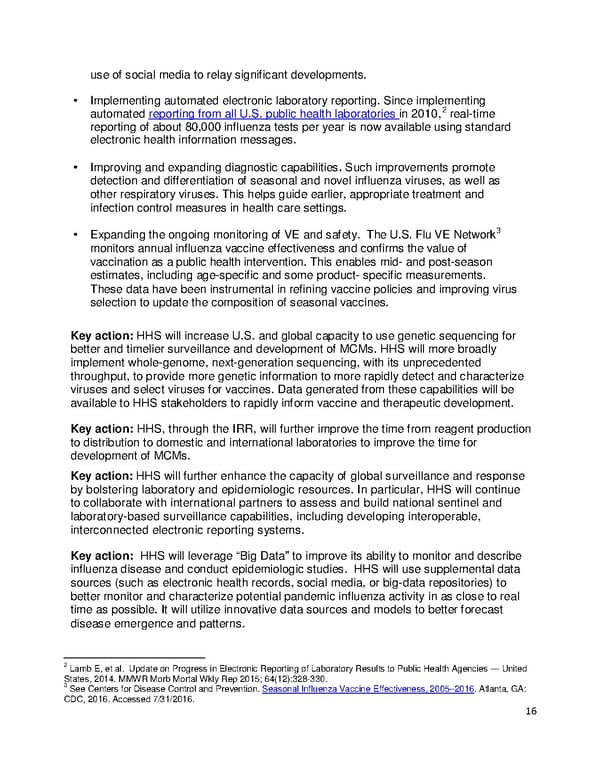use of social media to relay significant developments. • Implementing automated electronic laboratory reporting. Since implementing 2 automated reporting from all U.S. public health laboratories in 2010, real-time reporting of about 80,000 influenza tests per year is now available using standard electronic health information messages. • Improving and expanding diagnostic capabilities. Such improvements promote detection and differentiation of seasonal and novel influenza viruses, as well as other respiratory viruses. This helps guide earlier, appropriate treatment and infection control measures in health care settings. 3 • Expanding the ongoing monitoring of VE and safety. The U.S. Flu VE Network monitors annual influenza vaccine effectiveness and confirms the value of vaccination as a public health intervention. This enables mid- and post-season estimates, including age-specific and some product- specific measurements. These data have been instrumental in refining vaccine policies and improving virus selection to update the composition of seasonal vaccines. Key action: HHS will increase U.S. and global capacity to use genetic sequencing for better and timelier surveillance and development of MCMs. HHS will more broadly implement whole-genome, next-generation sequencing, with its unprecedented throughput, to provide more genetic information to more rapidly detect and characterize viruses and select viruses for vaccines. Data generated from these capabilities will be available to HHS stakeholders to rapidly inform vaccine and therapeutic development. Key action: HHS, through the IRR, will further improve the time from reagent production to distribution to domestic and international laboratories to improve the time for development of MCMs. Key action: HHS will further enhance the capacity of global surveillance and response by bolstering laboratory and epidemiologic resources. In particular, HHS will continue to collaborate with international partners to assess and build national sentinel and laboratory-based surveillance capabilities, including developing interoperable, interconnected electronic reporting systems. Key action: HHS will leverage “Big Data” to improve its ability to monitor and describe influenza disease and conduct epidemiologic studies. HHS will use supplemental data sources (such as electronic health records, social media, or big-data repositories) to better monitor and characterize potential pandemic influenza activity in as close to real time as possible. It will utilize innovative data sources and models to better forecast disease emergence and patterns. 2 Lamb E, et al. Update on Progress in Electronic Reporting of Laboratory Results to Public Health Agencies — United States, 2014. MMWR Morb Mortal Wkly Rep 2015; 64(12):328-330. 3 See Centers for Disease Control and Prevention. Seasonal Influenza Vaccine Effectiveness, 2005–2016. Atlanta, GA: CDC, 2016. Accessed 7/31/2016. 16
 Pandemic Influenza Plan Page 15 Page 17
Pandemic Influenza Plan Page 15 Page 17